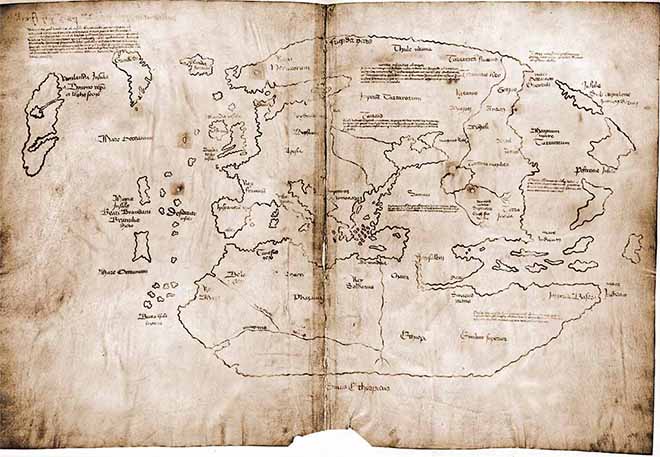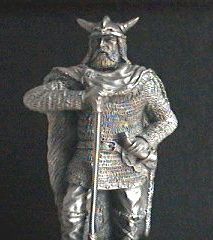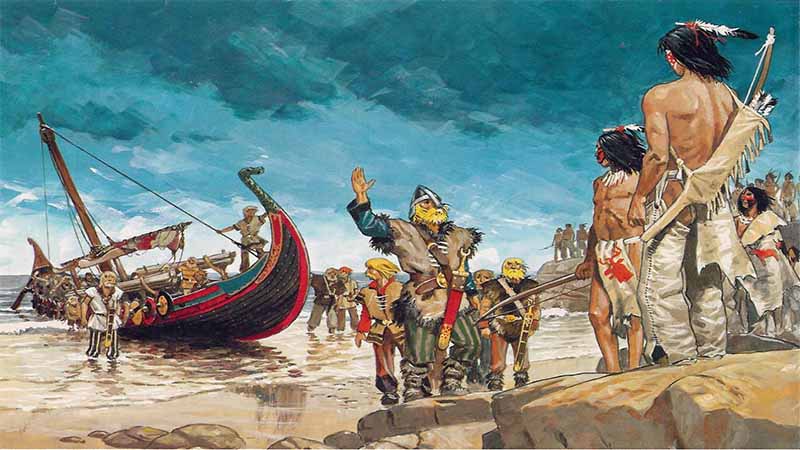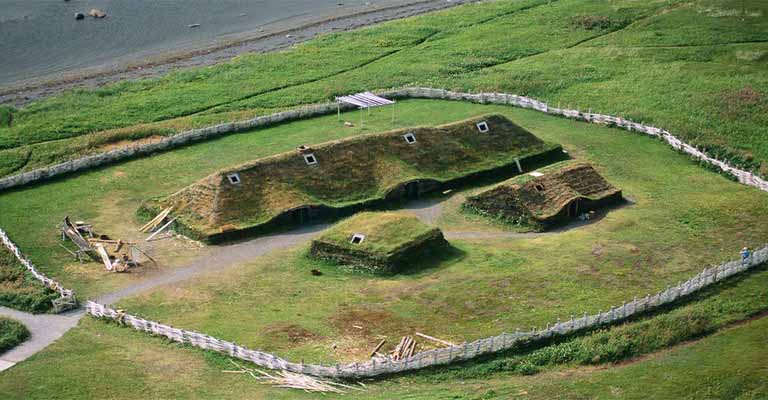Were Vikings in North America Before Columbus ?
The Vinland Sagas

The Vikings, these great Norse warriors as we imagine them fearlessly crossing northern seas, might have discovered the lands of America (Vinland) in the eleventh century, several hundred years before the expeditions of famous marine explorer Christopher Columbus. Many medieval Vikings sagas seem to confirm this as does a settlement discovered at Anse aux Meadows in 1960, whose origins are probably Norse.
The mythical Vikings Vinland

Two medieval texts are particularly eloquent about Vinland and relate Vikings exploration adventures starting from the island of Greenland. These stories are the Saga of the Greenlanders and the Saga of Erik the Red which together form what is designated under the name of the Vinland sagas. Their chronologies and historical veridicity remains highly controversial, but some suggest the year 1000 as a reference point in time, the year of the death of Norwegian king Olaf Tryggvason.
Other ancient documents and Viking rune stones also mention a mythical land called the Vinland: the stone of Honen whose engravings were interpreted in the nineteenth century and dates back to the first half of the eleventh century, the chronicles of Adam of Bremen, Icelandic literature of the first decades of the twelfth century ... Also, apparently Vikings relics were found in America as the Kensington Runestone or that of Popham Beach as well as the Newport Tower. These relics, however, are considered deceit nowadays and researchers do not give them any credibility as to the attestation of the presence of Vikings in North America.

The Saga of Erik the Red
After being banished from Icelandic kingdom, Viking Eric the Red exiles on the island of Greenland where he founds the first Norse settlements in the southwest of the icy continent. A few years later, his own son, Leif Erikson, is sent on a mission to Greenland by King Olaf to convert inhabitants to Christianity. The year after (year 1000 according to a hypothetical chronology), as he prepares to return to Norway, Leif Erikson unexpectedly discovers land hitherto unknown to Europeans in southern Greenland. He calls them Vinland in reference to vineyards and the abundance of wheat fields.
The Saga of the Greenlanders

In this second Vinland saga, navigator and merchant Bjarni Herjólfsson goes to Iceland and then continues his way towards Greenland. While trying to find his father who was part of Erik the Red's crew, Bjarni and his Viking ship are caught in violent storms sending it adrift further south. Going back north towards the shores of Greenland, Bjarni Herjólfsson sees wooded and mountainous grounds in the distance but chooses not to stop there. When he finally reaches viking settlements southwest of Greenland, Bjarni stories arouse the interest of Leif Erikson who pursues the mythical islands. Going down south, Erikson first discovers Helluland (Baffin Island) followed by Markland (Labrador) and finally Vinland (possibly Newfoundland ?), where he temporarily sets up camp. Norse Leif Erikson thus becomes the first European to set foot on American grounds. The Saga of the Greenlanders then recounts in turn the successive expeditions towards Vinland of Erikson's brother, Thorvald Erikson, as well as those of Thorfinn Karlsefni and Freydis Eiriksdottir.
Historical truth ?
The historical authenticity of the Vinland Sagas stories is open to debate; for a large number of historians of the nineteenth century, the texts were written during the thirteenth century but are based on oral traditions describing real events. So according to this theory, Vikings would've indeed discovered America before Columbus. For others, and especially exegetes of the twentieth century, the two sagas are a work of pure fiction invented by educated monks. It is, however, very easy to imagine that if Vikings could reach the coast of Greenland from Iceland or Norway, some kind of historical reality must lie behind these medieval manuscripts. In addition, one wonders where monks could've drawn the inspiration to write such stories ...?
The mysteries of archeology
If Vikings actually set foot in America and set up camp there before returning to Greenland, surely there must be archaeological evidence scattered throughout northern regions. For example, archaeologists have found traces of anthracite, a rock found only further south, in a Greenland Viking farm. Not far from there, they also found native arrowheads which the Vikings could've brought back from their confrontations at Vinland as well as tombs made of larch wood; only found further south on the Labrador Peninsula.
Viking settlements in Canada

Until today, the best evidence of Vikings in North America was discovered in 1960 at Anse aux Meadows by a couple of archaeologists, Helge Ingstad and his wife Anne Stine. The complex, located in northern Newfoundland, is very similar to the large Vikings farm found in Greenland and Iceland. In addition, carbon 14 dating allowed to establish a correspondence with the Vinland Sagas timeline; the Anse aux Meadows site served as a landmark at the beginning of the second millennium. Composed of three large houses made of peat and gravel, the place could accommodate nearly 100 people and looks much more like a housing complex than simple camps.
In addition to the three main buildings, the site also includes other buildings of lesser importance such as workshops and warehouse huts. If the Vikings used this place as an encampment, it was only temporary, even if for a few decades since no burials or even personal items were found at Anse aux Meadows. Inhabitants didn't practice agriculture and lived exclusively on hunting and fishing.
Other possible Viking remains in north america
In 2016, modern satellite imaging research techniques led Sarah Parcak and a group of researchers to locate a second Viking occupation site in the province of Newfoundland at Point Rosee. Evidences, however, remains inconclusive.









































































































































































































































































































































